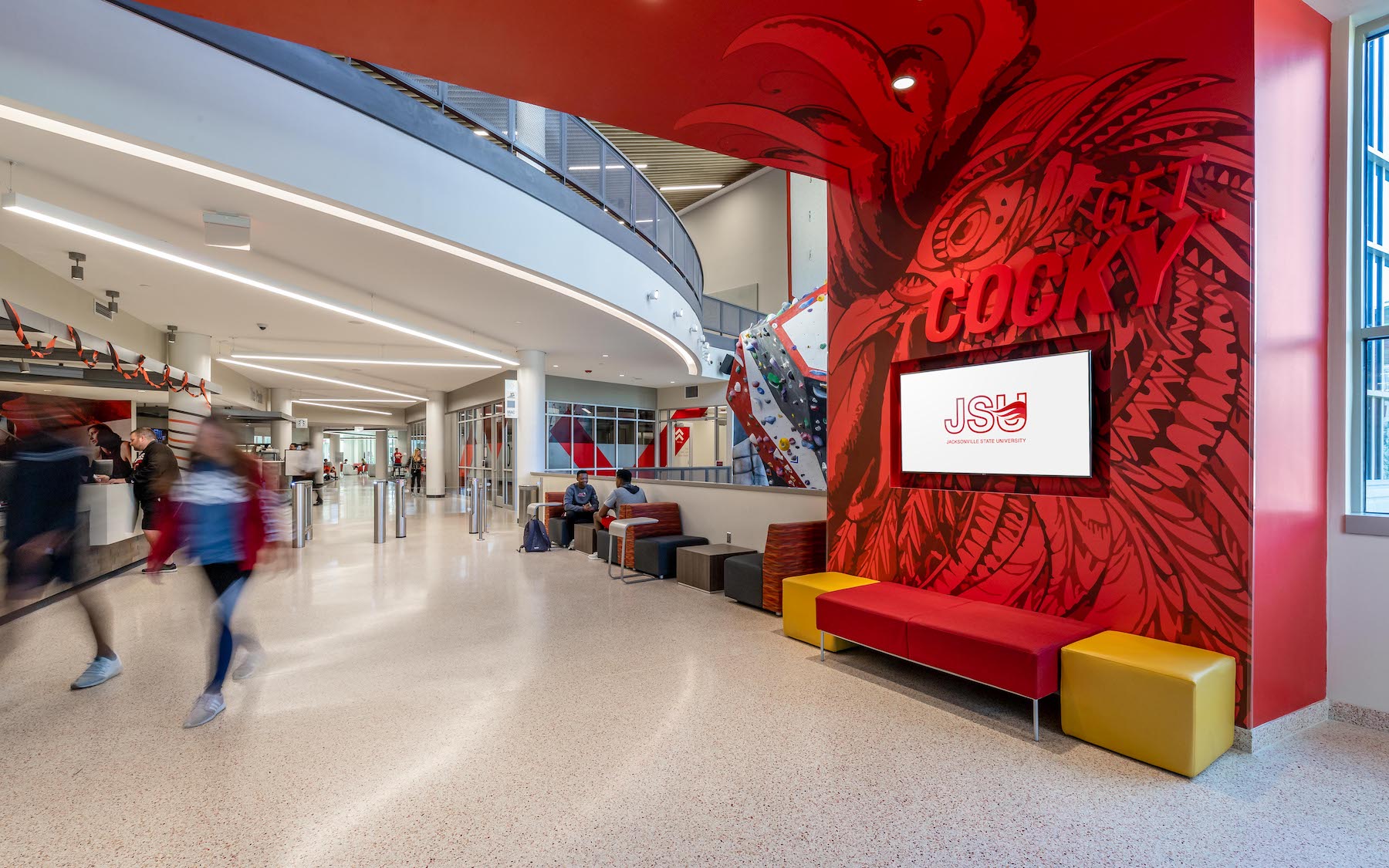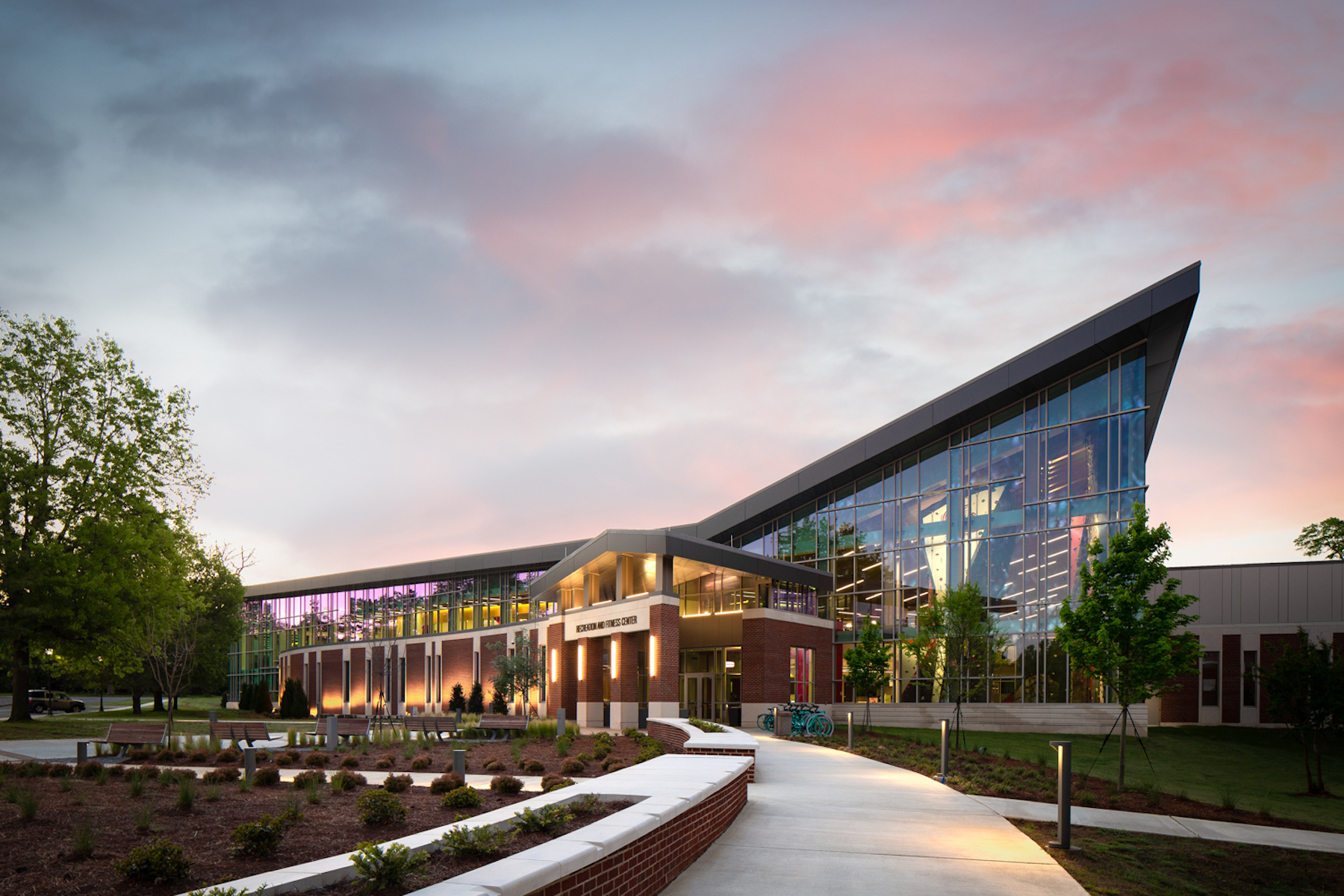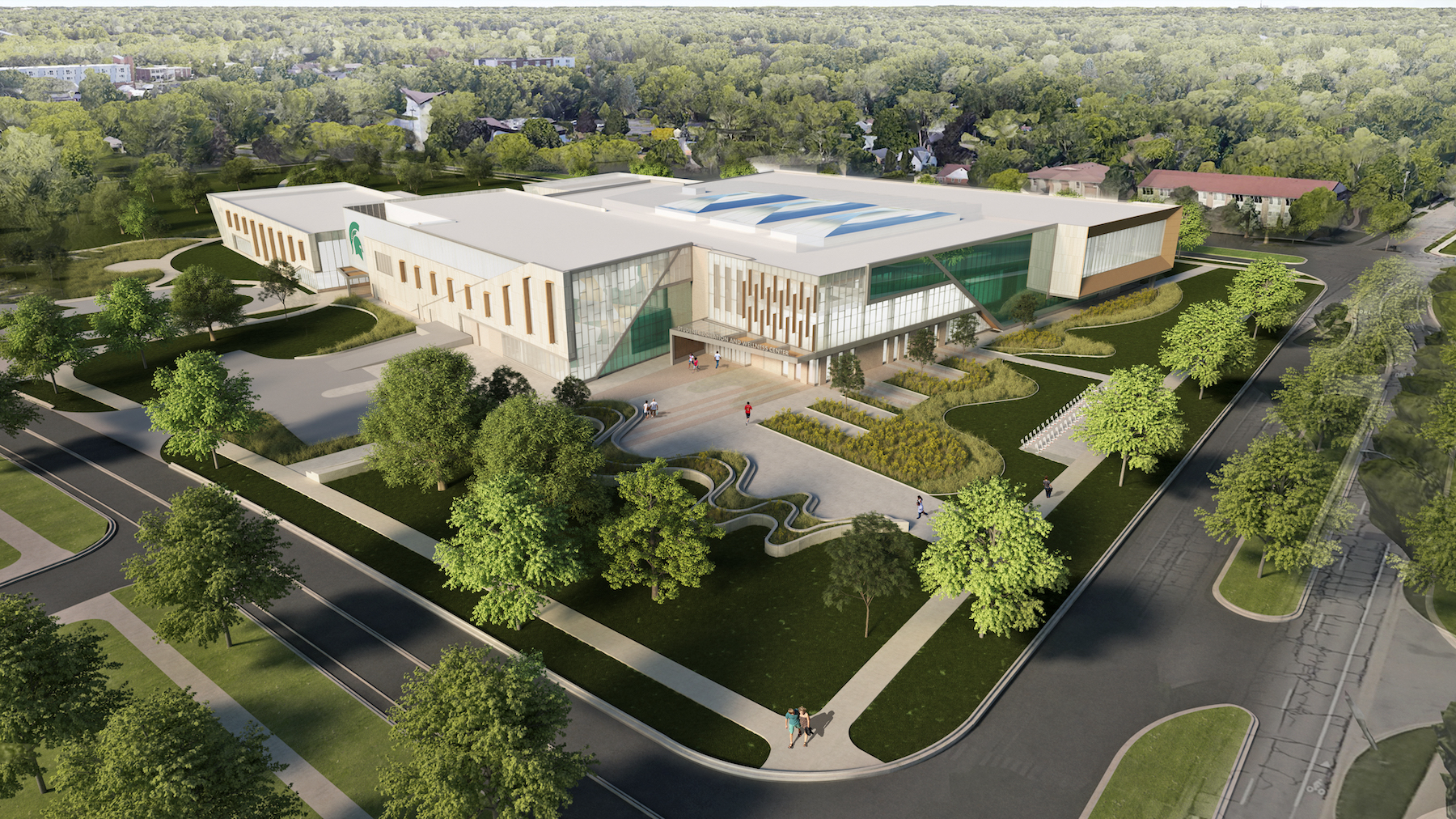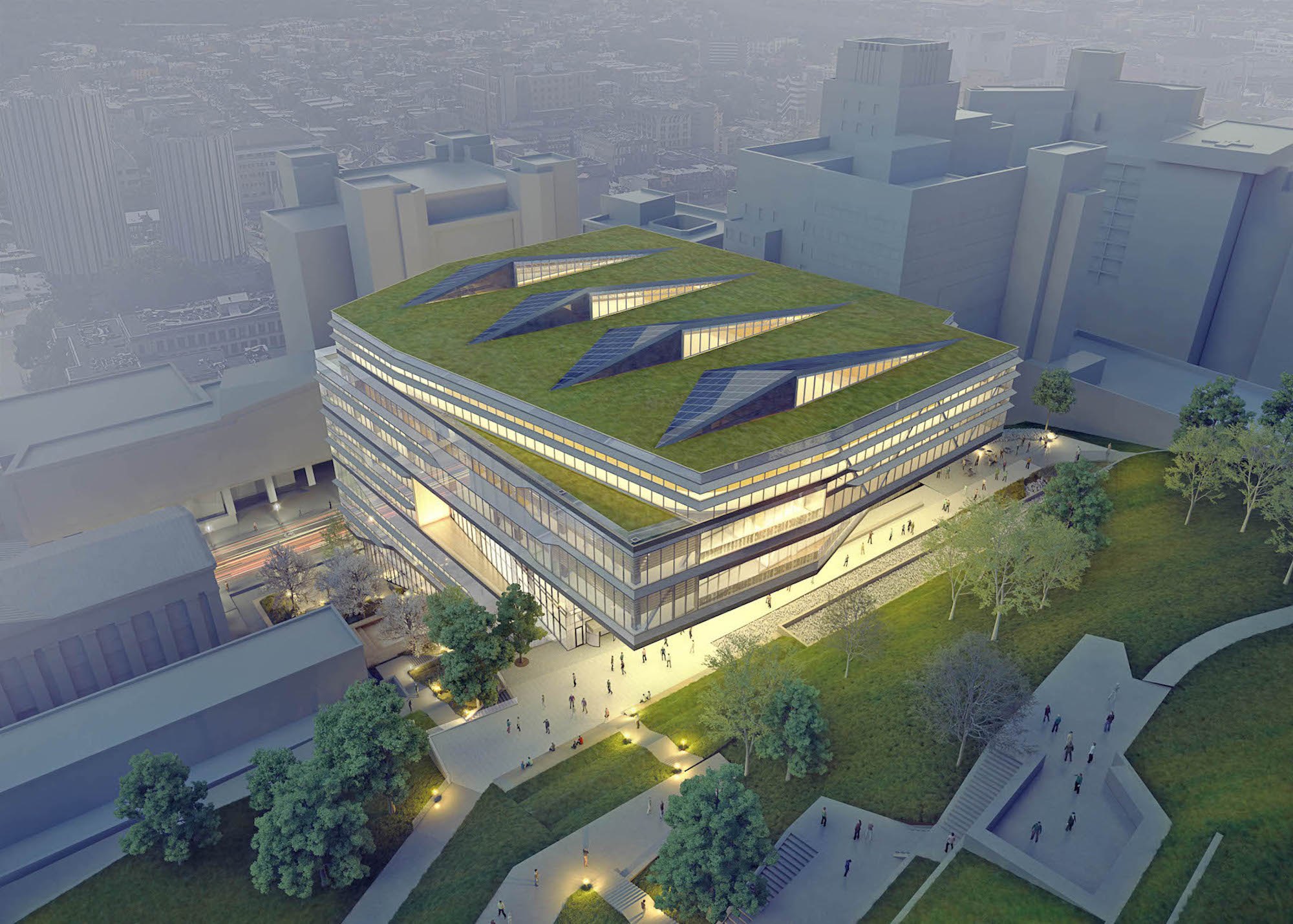On September 29 of last year, the University of Pittsburgh broke ground at its Oakland campus on a new Recreation and Wellness Center, a $255 million project whose 270,000 square feet will spread over nine stories, making this the tallest building of its kind in the U.S. when it opens in the fall of 2024.
Around the same time of the groundbreaking, Michigan State University in East Lansing was moving forward on its plans for a three-story 300,000-sf Health and Wellness Center that is scheduled to open in 2025, and whose design and programming were informed by focus groups with students.
The common thread connecting these projects is their design architect, Columbus, Ohio-based Moody Nolan, which celebrates its 40th anniversary last year. Over the past quarter-century, Moody Nolan has become one of the industry’s leading specialists in the creation of collegiate recreation facilities, according to Campus Rec magazine. The firm’s signature in this typology is designing rec centers to be campus destinations.
As such, Moody Nolan has had a ringside seat to watch how demand for rec centers has evolved to incorporate user well-being. “Our clients aren’t only concerned about physical space, but are also asking ‘why’ about these projects,” says Troy Sherrard, FAIA, a Partner and Sports + Recreation Practice Design Leader, who has been with the firm for 20 years. Consequently, he continues, more clients are requesting “hybrid environments” that “build habits” for health and wellness in students.
Shared spaces a priority for recreation centers


Sherrard says that certain “traditional” spaces, like athletic fields and courts, and even aquatic amenities, are still must haves in rec centers. On the other hand, Moody Nolan has seen less demand lately for racquet sports spaces, and more demand for “shared spaces,” such as turf gyms within fieldhouses, and climbing and bouldering options. Clients also want multipurpose rooms for activities that range from “high energy to mediation,” says Sherrard, who spoke with BD+C last week.
He points specifically to the 101,000-sf, $30 million rec center at Jacksonville State University in Alabama, which opened in January 2019. Sherrard says prior to that opening, fitness and wellness were not prevalent concerns for most rural southern schools. Jacksonville State, conversely, saw the new rec center—which would have the largest footprint of any building on its campus—as one of its “anchors.”
The building’s highlights, says Sherrard, feature a 43-ft-tall outdoor climbing wall, social engagement spaces that include a campus “living room,” and an outdoor “adventure” component for biking and walking. Sherrard adds that rec centers need to be immersive, which in Jacksonville State’s case meant telling a design story through branding “to root the student in a sense of place.” (He notes that anyone walking into this rec center can see most of its rooms at first glance.)
How recreation centers can reinforce student health
After Jacksonville State opened its rec center, its enrollment for the next fall semester jumped by 6 percent. (The school’s full- and parttime enrollment for the fall of 2022 was 9,633, compared to 7,696 in the spring of 2018.)
Other campuses around the country flaunt their recreational and athletic facilities as recruitment bait. “That always comes up, and without [a rec center] there’s a void,” says Sherrard. He points out that Penn State University’s rec center (designed by his firm) is across the street from the college’s Admissions building, so the rec center is the first thing prospective and incoming students and their parents see, accentuating the college’s commitment to health and wellness.

Appealing to student needs is at the forefront of rec center design and operations, says Sherrard. Moody Nolan’s focus groups for the Michigan State University project (for which Rossetti is the AOR) revealed two desired trends that became key design drivers: biophilia and what Sherrard calls “zones for discovery.”
This rec center’s design is created around a courtyard. According to MSU, the building’s front façade opens to an outdoor greenspace with “large spans of glass for natural daylight and ventilation, allowing for integrated indoor-outdoor functional fitness experiences.”
Each floor of Pitt’s Recreation and Wellness center will have a different emphasis: dining, free weights, swimming and aquatic exercise, a gym, a jogging track, a multipurpose room, etc. The building itself, built into an 85-ft hillside, will connect Pitt’s upper and lower campuses. Also built into the hillside will be a 160-step “Panther Run,” that includes an outdoor platform halfway up for fitness classes.
Given its verticality, Pitt’s Recreation and Wellness center “could be a game changer” for urban-situated rec centers, says Sherrard.
Related Stories
| Nov 9, 2010
Designing a library? Don’t focus on books
How do you design a library when print books are no longer its core business? Turn them into massive study halls. That’s what designers did at the University of Amsterdam, where they transformed the existing 27,000-sf library into a study center—without any visible books. About 2,000 students visit the facility daily and encounter workspaces instead of stacks.
| Nov 3, 2010
First of three green labs opens at Iowa State University
Designed by ZGF Architects, in association with OPN Architects, the Biorenewable Research Laboratory on the Ames campus of Iowa State University is the first of three projects completed as part of the school’s Biorenewables Complex. The 71,800-sf LEED Gold project is one of three wings that will make up the 210,000-sf complex.
| Nov 3, 2010
Seattle University’s expanded library trying for LEED Gold
Pfeiffer Partners Architects, in collaboration with Mithun Architects, programmed, planned, and designed the $55 million renovation and expansion of Lemieux Library and McGoldrick Learning Commons at Seattle University. The LEED-Gold-designed facility’s green features include daylighting, sustainable and recycled materials, and a rain garden.
| Nov 3, 2010
Recreation center targets student health, earns LEED Platinum
Not only is the student recreation center at the University of Arizona, Tucson, the hub of student life but its new 54,000-sf addition is also super-green, having recently attained LEED Platinum certification.
| Nov 3, 2010
Virginia biofuel research center moving along
The Sustainable Energy Technology Center has broken ground in October on the Danville, Va., campus of the Institute for Advanced Learning and Research. The 25,000-sf facility will be used to develop enhanced bio-based fuels, and will house research laboratories, support labs, graduate student research space, and faculty offices. Rainwater harvesting, a vegetated roof, low-VOC and recycled materials, photovoltaic panels, high-efficiency plumbing fixtures and water-saving systems, and LED light fixtures will be deployed. Dewberry served as lead architect, with Lord Aeck & Sargent serving as laboratory designer and sustainability consultant. Perigon Engineering consulted on high-bay process labs. New Atlantic Contracting is building the facility.
| Nov 3, 2010
Dining center cooks up LEED Platinum rating
Students at Bowling Green State University in Ohio will be eating in a new LEED Platinum multiuse dining center next fall. The 30,000-sf McDonald Dining Center will have a 700-seat main dining room, a quick-service restaurant, retail space, and multiple areas for students to gather inside and out, including a fire pit and several patios—one of them on the rooftop.
| Nov 1, 2010
John Pearce: First thing I tell designers: Do your homework!
John Pearce, FAIA, University Architect at Duke University, Durham, N.C., tells BD+C’s Robert Cassidy about the school’s construction plans and sustainability efforts, how to land work at Duke, and why he’s proceeding with caution when it comes to BIM.
| Oct 13, 2010
Editorial
The AEC industry shares a widespread obsession with the new. New is fresh. New is youthful. New is cool. But “old” or “slightly used” can be financially profitable and professionally rewarding, too.
| Oct 13, 2010
Campus building gives students a taste of the business world
William R. Hough Hall is the new home of the Warrington College of Business Administration at the University of Florida in Gainesville. The $17.6 million, 70,000-sf building gives students access to the latest technology, including a lab that simulates the stock exchange.
| Oct 13, 2010
Science building supports enrollment increases
The new Kluge-Moses Science Building at Piedmont Virginia Community College, in Charlottesville, is part of a campus update designed and managed by the Lukmire Partnership. The 34,000-sf building is designed to be both a focal point of the college and a recruitment mechanism to get more students enrolling in healthcare programs.
















